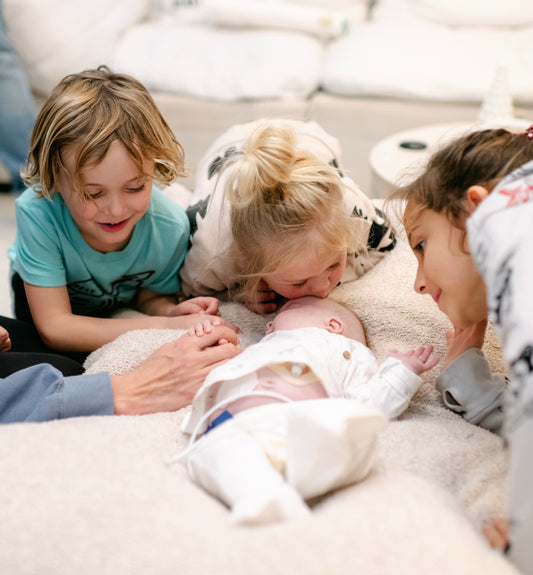
Margey is a stay-at-home mom in Oklahoma, living life with her boyfriend and their son, Maverick. But her life is anything but the average stay-at-home life. They own horse stables. When Maverick made his debut in the world, the horses still needed their tending to, so Margey has turned to babywearing as her saving grace.
“He's glued to my back 24/7. I have barn chores and duties that I have to tend to...We get up at 7:00 AM when we feed, and after I feed, I walk by every horse and let [Maverick] pet each and every one. He throws a fit if we miss one. I don't even know how he knows at such a young age that we missed that part.
I didn't know how I was going to juggle it before I found baby carriers. I don’t even know if I would be able to still work with the horses.”
But becoming a mom and watching her son experience her world from the vantage point of her back has been a surprising joy. “Life since I became a mom has been the funnest thing ever. And I do everything that I can with Maverick, just carrying him, he gets to explore the world from my view just like a few inches behind me.”
Can you ride a horse while pregnant?Riding a horse while pregnant can be risky, and it's important to prioritize the safety and well-being of both the mother and the developing baby. Horseback riding carries the potential for falls or sudden jolts, which can pose a danger to a pregnant woman and her fetus. Additionally, the motion and impact from riding can be uncomfortable, especially as the pregnancy progresses. It is generally recommended to avoid horseback riding during pregnancy, especially if you are not an experienced rider. If you are an experienced rider and choose to continue riding during pregnancy, it is crucial to consult with your healthcare provider for personalized advice and to take necessary precautions, such as wearing appropriate protective gear, riding a well-trained horse, and avoiding risky activities or jumps. Ultimately, the decision to ride a horse while pregnant should be made in consultation with your healthcare provider, who can assess your individual health, the specific circumstances, and provide guidance based on your unique situation. |
Animals as Companions

Margey bred one of her mares and not long after the mare became pregnant, Margey found out she was pregnant too. The horse was born in early 2022 and Maverick a few months later. “They’re best buds. That horse used to just follow me around, and I think he was following me around waiting for this baby to come out. And now they're just like, the best buds. He'll lay down with him in the grass and all kind of stuff.”
Maverick is more than just a best bud to his horse, that Margey jokes is like the puppy dog that most other kids get when they’re a kid. Maverick has also become a clever tool to bring horses where they need to go, when they otherwise don’t want to listen.
“We have a baby race horse who is about 6 months old that we can't catch. We'll bring [Maverick] to the fence, and then we catch him using this baby. I don't know if they can talk to each other or what, but they all know that he's a baby. We have one stallion who's a little bit of a **** hole. He bites, but he won’t bite my baby. My baby will sit there and play and pull all over his face. But he won't bite him.”
How to introduce a baby to horses?Introducing a baby to a horse should be done with utmost care and attention to safety. Here are some steps to help ensure a safe and positive introduction:
- Pick a calm and quiet environment where both the baby and the horse can feel comfortable. - Ensure the horse is well-trained and known for its gentle and predictable behavior.
- Always have responsible and experienced adults present during the introduction. - Have at least one person dedicated solely to ensuring the baby's safety.
- Start by allowing the baby to observe the horse from a safe distance, such as behind a fence or a gate. *Margey kept Maverick in a stroller in the stables so they could observe each other from a distance. - Let the baby become familiar with the horse's appearance, movements, and sounds.
- Once the baby appears comfortable and curious, you can bring them closer to the horse, still maintaining a safe distance. - Keep the initial interactions short and positive to prevent overwhelming either the baby or the horse.
- Under close supervision, allow the baby to gently touch or stroke the horse's muzzle or neck while reassuring both the baby and the horse with soothing words.
- Pay attention to the body language of both the baby and the horse. Look for signs of fear, discomfort, or stress, and be prepared to step back if necessary.
- Use positive reinforcement for both the baby and the horse. Offer praise, treats, or gentle petting to reward calm and appropriate behavior.
- Keep in mind that horses are large animals, and even the gentlest horse can unintentionally cause harm if startled or spooked. Always prioritize safety.
- Over time, you can gradually increase the level of interaction as both the baby and the horse become more comfortable with each other.
- Teach the baby from a young age to respect the boundaries of the horse and not to approach or touch the horse without supervision. |
Together, Margey and her little family are continuing a legacy that began generations before. The hat Margey wears is a piece that’s more than functional. “The cool thing about this hat it was my grandpa's hat and then he passed it down to my dad and then I took it from my dad. So then one day Maverick will be able to take it from me.”
When it comes to raising horses and humans, there is at least one important quality Margey has noticed that apply to both: patience. “The number one thing with people and animals is patience. You have got to have a lot of patience in just every aspect of life. [And] that's one of the really big things that I'm trying to instill in [Maverick].”
Follow Margey and all her Oklahoma ranch fun on Instagram and TikTok.
[Shop the carriers Margey loves.]






